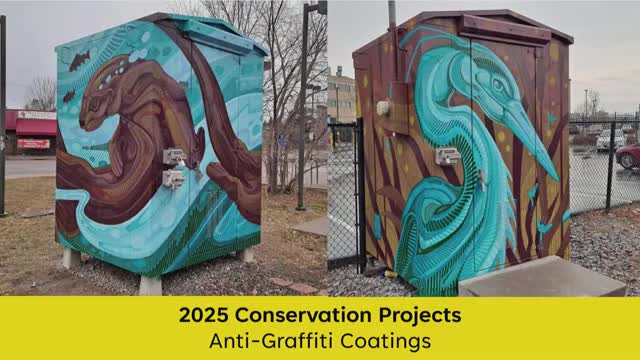Public Art Program Enhance Graffiti Removal and Community Engagement Across Minneapolis
March 23, 2025 | Metropolitan Council, Agencies, Boards, & Commissions, Executive, Minnesota
This article was created by AI summarizing key points discussed. AI makes mistakes, so for full details and context, please refer to the video of the full meeting. Please report any errors so we can fix them. Report an error »

The Minnesota Metropolitan Council is making strides in enhancing public art and reducing vandalism through innovative conservation and maintenance strategies. During a recent meeting, officials highlighted the success of their anti-graffiti initiatives, which have significantly decreased graffiti incidents on public artworks.
One of the key developments discussed was the application of anti-graffiti coatings on murals and other surfaces. This year, the council reported a reduction in graffiti incidents from 20 to 12, thanks to these protective measures. The council has also employed a conservation technician to oversee maintenance projects, including the treatment of stainless steel panels at transit stations, which have been prone to rust due to environmental factors.
In addition to protective coatings, the council is actively promoting the installation of murals in areas frequently targeted by graffiti. Two crossing houses were muralized last summer, resulting in a complete absence of graffiti since their installation. The council is also experimenting with anti-graffiti wallpaper in elevator lobbies, which has shown promising results in reducing vandalism.
The meeting also showcased the council's bus shelter beautification program, which has successfully reduced graffiti by 60% and vandalism by 50% through the use of artistic clings designed by local artists. This initiative not only beautifies the transit environment but also fosters community engagement by involving local artists and organizations.
Looking ahead, the council plans to expand its public art initiatives in 2025, including new murals and art installations at various transit locations. These efforts aim to create a more vibrant and welcoming atmosphere for transit users while simultaneously addressing maintenance challenges.
Overall, the Metropolitan Council's commitment to public art and community involvement is paving the way for a more aesthetically pleasing and safer transit experience in Minnesota. As these programs continue to evolve, they promise to enhance the cultural landscape of the region while fostering a sense of ownership and pride among residents.
One of the key developments discussed was the application of anti-graffiti coatings on murals and other surfaces. This year, the council reported a reduction in graffiti incidents from 20 to 12, thanks to these protective measures. The council has also employed a conservation technician to oversee maintenance projects, including the treatment of stainless steel panels at transit stations, which have been prone to rust due to environmental factors.
In addition to protective coatings, the council is actively promoting the installation of murals in areas frequently targeted by graffiti. Two crossing houses were muralized last summer, resulting in a complete absence of graffiti since their installation. The council is also experimenting with anti-graffiti wallpaper in elevator lobbies, which has shown promising results in reducing vandalism.
The meeting also showcased the council's bus shelter beautification program, which has successfully reduced graffiti by 60% and vandalism by 50% through the use of artistic clings designed by local artists. This initiative not only beautifies the transit environment but also fosters community engagement by involving local artists and organizations.
Looking ahead, the council plans to expand its public art initiatives in 2025, including new murals and art installations at various transit locations. These efforts aim to create a more vibrant and welcoming atmosphere for transit users while simultaneously addressing maintenance challenges.
Overall, the Metropolitan Council's commitment to public art and community involvement is paving the way for a more aesthetically pleasing and safer transit experience in Minnesota. As these programs continue to evolve, they promise to enhance the cultural landscape of the region while fostering a sense of ownership and pride among residents.
View full meeting
This article is based on a recent meeting—watch the full video and explore the complete transcript for deeper insights into the discussion.
View full meeting
